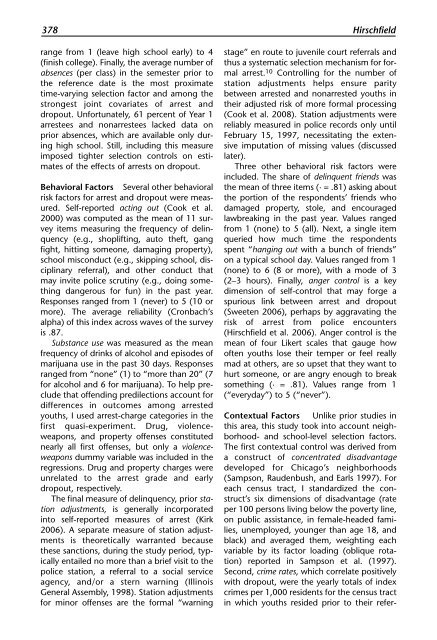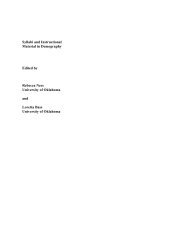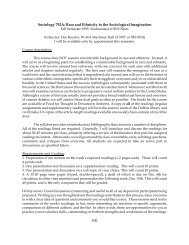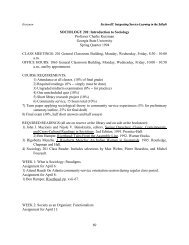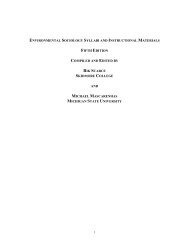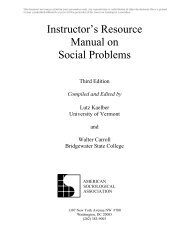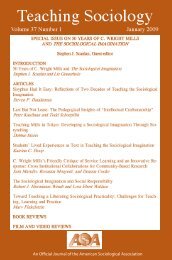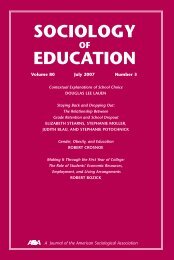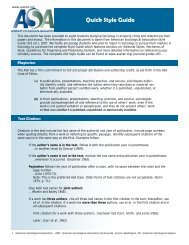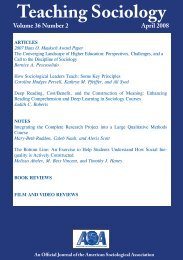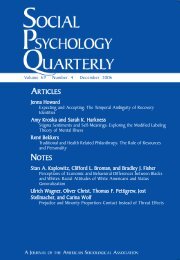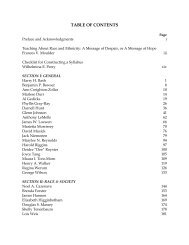SOCIOLOGY EDUCATION - American Sociological Association
SOCIOLOGY EDUCATION - American Sociological Association
SOCIOLOGY EDUCATION - American Sociological Association
You also want an ePaper? Increase the reach of your titles
YUMPU automatically turns print PDFs into web optimized ePapers that Google loves.
378 Hirschfield<br />
range from 1 (leave high school early) to 4<br />
(finish college). Finally, the average number of<br />
absences (per class) in the semester prior to<br />
the reference date is the most proximate<br />
time-varying selection factor and among the<br />
strongest joint covariates of arrest and<br />
dropout. Unfortunately, 61 percent of Year 1<br />
arrestees and nonarrestees lacked data on<br />
prior absences, which are available only during<br />
high school. Still, including this measure<br />
imposed tighter selection controls on estimates<br />
of the effects of arrests on dropout.<br />
Behavioral Factors Several other behavioral<br />
risk factors for arrest and dropout were measured.<br />
Self-reported acting out (Cook et al.<br />
2000) was computed as the mean of 11 survey<br />
items measuring the frequency of delinquency<br />
(e.g., shoplifting, auto theft, gang<br />
fight, hitting someone, damaging property),<br />
school misconduct (e.g., skipping school, disciplinary<br />
referral), and other conduct that<br />
may invite police scrutiny (e.g., doing something<br />
dangerous for fun) in the past year.<br />
Responses ranged from 1 (never) to 5 (10 or<br />
more). The average reliability (Cronbach’s<br />
alpha) of this index across waves of the survey<br />
is .87.<br />
Substance use was measured as the mean<br />
frequency of drinks of alcohol and episodes of<br />
marijuana use in the past 30 days. Responses<br />
ranged from “none” (1) to “more than 20” (7<br />
for alcohol and 6 for marijuana). To help preclude<br />
that offending predilections account for<br />
differences in outcomes among arrested<br />
youths, I used arrest-charge categories in the<br />
first quasi-experiment. Drug, violenceweapons,<br />
and property offenses constituted<br />
nearly all first offenses, but only a violenceweapons<br />
dummy variable was included in the<br />
regressions. Drug and property charges were<br />
unrelated to the arrest grade and early<br />
dropout, respectively.<br />
The final measure of delinquency, prior station<br />
adjustments, is generally incorporated<br />
into self-reported measures of arrest (Kirk<br />
2006). A separate measure of station adjustments<br />
is theoretically warranted because<br />
these sanctions, during the study period, typically<br />
entailed no more than a brief visit to the<br />
police station, a referral to a social service<br />
agency, and/or a stern warning (Illinois<br />
General Assembly, 1998). Station adjustments<br />
for minor offenses are the formal “warning<br />
stage” en route to juvenile court referrals and<br />
thus a systematic selection mechanism for formal<br />
arrest. 10 Controlling for the number of<br />
station adjustments helps ensure parity<br />
between arrested and nonarrested youths in<br />
their adjusted risk of more formal processing<br />
(Cook et al. 2008). Station adjustments were<br />
reliably measured in police records only until<br />
February 15, 1997, necessitating the extensive<br />
imputation of missing values (discussed<br />
later).<br />
Three other behavioral risk factors were<br />
included. The share of delinquent friends was<br />
the mean of three items (· = .81) asking about<br />
the portion of the respondents’ friends who<br />
damaged property, stole, and encouraged<br />
lawbreaking in the past year. Values ranged<br />
from 1 (none) to 5 (all). Next, a single item<br />
queried how much time the respondents<br />
spent “hanging out with a bunch of friends”<br />
on a typical school day. Values ranged from 1<br />
(none) to 6 (8 or more), with a mode of 3<br />
(2–3 hours). Finally, anger control is a key<br />
dimension of self-control that may forge a<br />
spurious link between arrest and dropout<br />
(Sweeten 2006), perhaps by aggravating the<br />
risk of arrest from police encounters<br />
(Hirschfield et al. 2006). Anger control is the<br />
mean of four Likert scales that gauge how<br />
often youths lose their temper or feel really<br />
mad at others, are so upset that they want to<br />
hurt someone, or are angry enough to break<br />
something (· = .81). Values range from 1<br />
(“everyday”) to 5 (“never”).<br />
Contextual Factors Unlike prior studies in<br />
this area, this study took into account neighborhood-<br />
and school-level selection factors.<br />
The first contextual control was derived from<br />
a construct of concentrated disadvantage<br />
developed for Chicago’s neighborhoods<br />
(Sampson, Raudenbush, and Earls 1997). For<br />
each census tract, I standardized the construct’s<br />
six dimensions of disadvantage (rate<br />
per 100 persons living below the poverty line,<br />
on public assistance, in female-headed families,<br />
unemployed, younger than age 18, and<br />
black) and averaged them, weighting each<br />
variable by its factor loading (oblique rotation)<br />
reported in Sampson et al. (1997).<br />
Second, crime rates, which correlate positively<br />
with dropout, were the yearly totals of index<br />
crimes per 1,000 residents for the census tract<br />
in which youths resided prior to their refer-


